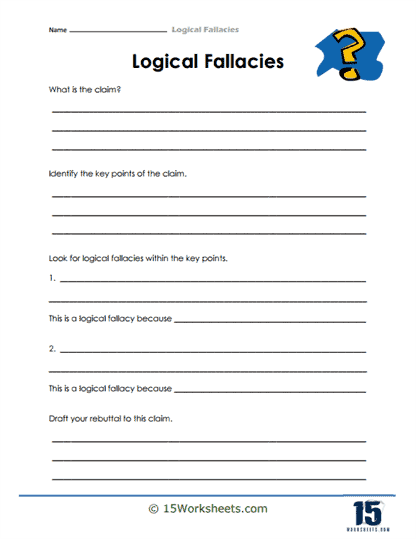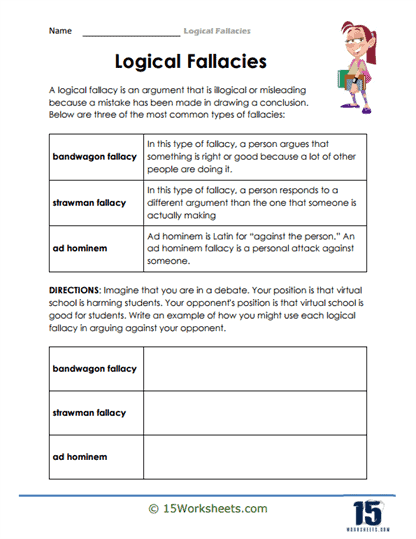Logical Fallacies Worksheets
About These 15 Worksheets
These worksheets help you understand and identify errors in reasoning or arguments. Logical fallacies are flaws in the logic or reasoning used to support a claim or make an argument. They can be misleading or deceptive, and they can weaken the strength or validity of an argument.
To explain logical fallacies, let’s look at an example – Imagine someone says, “Everyone knows that video games are bad because they make people violent.” This statement uses a logical fallacy called a sweeping generalization. It assumes that every person who plays video games becomes violent, which is an overgeneralization and not supported by evidence or logical reasoning.
Logical fallacies worksheets provide exercises and activities that help you recognize and analyze logical fallacies in arguments. These worksheets often contain examples of flawed reasoning, and you have to identify the specific fallacy being used.
By working on logical fallacies worksheets, you can:
Identify Logical Fallacies – Logical fallacies worksheets help you develop the skill of recognizing logical fallacies in reasoning. By analyzing arguments and statements, you learn to identify flaws or errors in logic. This skill allows you to critically evaluate the strength and validity of different arguments you encounter.
Understand Flawed Reasoning – Logical fallacies worksheets allow you to explore the types of flawed reasoning commonly used in arguments. You learn to spot patterns or techniques that can mislead or weaken an argument. By understanding logical fallacies, you become a more discerning and critical thinker.
Improve Critical Thinking – By learning about logical fallacies, you enhance your critical thinking skills. Logical fallacies highlight errors in reasoning and help you develop a more skeptical and analytical mindset. By practicing identifying and analyzing logical fallacies through worksheets, you become better equipped to evaluate arguments and make sound judgments.
Strengthen Arguments – Understanding logical fallacies helps you strengthen your own arguments. By recognizing common pitfalls in reasoning, you can avoid using flawed or deceptive logic. You learn to construct more solid and persuasive arguments based on sound reasoning and evidence.
Enhance Communication – Recognizing logical fallacies enhances your communication skills. By being aware of flawed reasoning, you can effectively challenge or counter flawed arguments. It allows you to engage in more productive discussions, identify weaknesses in others’ reasoning, and present your own viewpoints in a more convincing and logical manner.
Why Do Authors Use Logical Fallacies In Their Work?
Authors do not intentionally use logical fallacies in their work. Logical fallacies are flaws in reasoning or arguments that weaken the strength or validity of the intended message. The purpose of writing is to communicate ideas clearly and effectively, and authors strive to present logical and well-supported arguments.
However, authors may include characters or situations in their work that employ logical fallacies as part of the storytelling. This can serve several purposes:
Characterization – Characters who use logical fallacies in their reasoning can be portrayed as flawed or unreliable. This can add depth and complexity to their portrayal, making them more realistic and relatable. It allows authors to explore the consequences of flawed thinking or highlight the dangers of faulty reasoning.
Satire or Social Commentary – Authors may intentionally incorporate logical fallacies in their work as a form of satire or social commentary. By exaggerating or highlighting flawed reasoning, they can critique societal norms, expose hypocrisy, or challenge prevailing beliefs. Logical fallacies can be used to satirize flawed arguments or reveal the shortcomings of certain ideologies.
Plot Development – In some cases, authors may use logical fallacies as plot devices to create conflict or tension in the story. Characters’ flawed reasoning or misguided beliefs can lead to misunderstandings, plot twists, or unexpected outcomes. This can drive the narrative forward and keep readers engaged.
Critical Thinking and Analysis – Authors may introduce logical fallacies in their work to encourage readers to think critically and analyze the arguments presented. By presenting flawed reasoning, authors can prompt readers to question and evaluate the strength of the arguments, fostering a more thoughtful engagement with the text.
It is important to note that authors typically use logical fallacies within the context of the narrative to serve specific purposes. The inclusion of logical fallacies does not imply endorsement or promotion of flawed reasoning. Instead, it provides opportunities for readers to engage with the text, recognize errors in thinking, and develop their own critical thinking skills.















